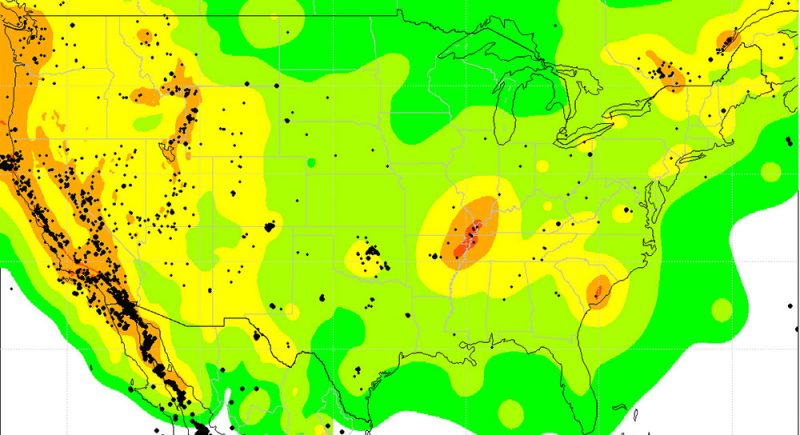Fracking waste and quakes
Underground storage of liquid waste from these mining operations can make an area more vulnerable to tremors

Earthquake activity has spiked recently in parts of the central United States where shale rock is increasingly being mined for natural gas and oil. Most of the quakes are small and don’t cause damage. But some of the small shakes may be signs that a larger one will strike soon in the area, scientists now report.
These small central U.S. quakes have been occurring near sites of hydraulic fracturing, or fracking. Fracking is one way companies draw natural gas or mixes of other hydrocarbons (such as crude oil) from underground deposits. The practice is becoming more common. To release the hydrocarbons, engineers drill holes in rock, then inject high-pressure fluids into the holes. These fluids break apart the shale, which is fragile. Over millions of years, rich deposits of natural gas or oil will often have built up between layers of this shale. As the rock breaks, the freed gas or oil is pumped to the surface.
Other fluids — including those injected in the holes — come to the surface, too. Those fluids may include toxic metals and other substances dangerous to people. So the waste is injected back underground.
Disposing of large amounts of liquid fracking waste underground has been linked to small quakes. But not at most sites. Rather, small quakes that do occur near these wastewater injection sites can be triggered by large, natural quakes halfway around the world, researchers say. They reported their findings in the July 12 issue of Science.
When a big earthquake strikes, it sends energy through the ground in the form of waves. Called seismic waves, these reach sites where fracking waste is injected underground. There, they may trigger a small quake.
The scientists reported that those little quakes, triggered by the big distant quakes, may be a sign of more shakes to come. They found that those little quakes preceded larger ones — in the same area — that followed in the next year or two. That connection suggests the wastewater fluid added pressure to a crack in Earth’s crust. These cracks are known as faults. When the rock on one side of a fault slips, an earthquake can occur.
Small quakes show “the faults are reaching a tipping point,” Nicholas van der Elst told Science News. This geologist at Columbia University’s Lamont-Doherty Earth Observatory in Palisades, N.Y., worked on the new study. The remote triggering of small quakes “seems to foreshadow larger induced earthquakes,” he explains.
Van der Elst and other researchers studied three wastewater injection sites where distant earthquakes preceded small tremors. One was in Prague, Okla.; another was in Snyder, Texas; and the third was in Trinidad, Colo. At each site, little earthquakes followed at least one of three powerful earthquakes: a 2010 quake in Chile, a 2011 quake in Japan, or a 2012 quake off the Indonesian island of Sumatra.
Those little quakes at the U.S. sites were just the beginning of tremors there. Each of those sites experienced moderate earthquakes between 6 and 20 months later. The scientists say small quakes at such sites may one day be used as a kind of warning that bigger earthquakes may soon rattle the same region.
Earthquakes are on the rise in the central and eastern United States, says seismologist William Ellsworth. He works at the U.S. Geological Survey in Menlo Park, Calif. Together, those regions experienced an average of 21 quakes of magnitude 3 or greater every year between 1967 and 2000. That area soon saw a sharp increase: Between 2010 and 2012, more than 100 such earthquakes, on average, were reported there every year. Ellsworth has just published his report on U.S. earthquake activity in the same issue of Science.
(Magnitude indicates the strength of an earthquake. The largest earthquake ever measured was a magnitude 9.5 earthquake that struck Chile in 1977. The moderate earthquakes that shook Oklahoma, Texas and Colorado fell between 4.3 and 5.7.)
There are tens of thousands of wastewater injection sites in the United States, according to the Environmental Protection Agency. Its officials recommend that companies with sites linked to earthquakes either try to stop the quakes — by injecting less waste, for instance — or shut down the sites entirely, EnergyWire reported online July 22.
Fortunately, “the vast majority don’t appear to induce earthquakes,” Ellsworth told Science News. Scientists don’t know why some of these wastewater injection sites cause earthquakes and others don’t.
The findings from the new studies won’t allow scientists to always be able to predict when medium-sized quakes might follow smaller shakes. The findings could, however, help scientists better understand the connection between quakes and the injection of wastewater underground.
Power Words
seismology The science concerned with earthquakes and related phenomena.
geology The science concerned with Earth’s physical structure and substance, its history and the processes that act on it.
earthquake A sudden and violent shaking of the ground, sometimes causing great destruction.
seismic wave A wave in the ground produced by an earthquake or other means.
hydraulic fracturing, or fracking The cracking open of undergound rocks by introducing liquid at high pressure, especially to extract natural gas. Those cracks are then held open by sand that had been added to the fracking fluid.







